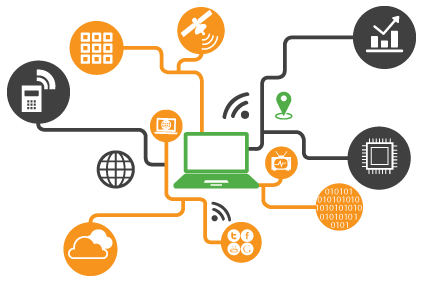
Challenges and issues raised by the IoT
The Internet of things is a buzz word which has been written about extensively. One could, however, define IoT as follows: “A network of Internet-connected objects able to collect and exchange data using embedded sensors” [1]. Its possible impact is global. It could affect countless industries (defence, agriculture, healthcare, connected home…) and devices (thermostats, kitchens, pacemakers..). Computers and smart phones are just the tip of the iceberg. Any device, with a wifi connection and that, can potentially be monitored from a remote location are concerned by this disruptive technology. And as with every disruption, it has its share of challenges and issues.
Privacy:
First of all, limitations must be implemented when it comes to data collection and controllership. To what extent would it be permissible to gather one’s data? Or, What should be the ideal frequency of data collection from those smart customers? Manufacturers have their share of responsibility as well. Respecting the guidelines given by international institutions regarding cyber security should be mandatory.
Second, for individual consumers, IoT is still a mysterious concept for the masses. Most of the current and potential customers in this industry are not aware of any processing of personal data taking place. Meanwhile, the amount of data collected and processed continues to ” increase substantially and will come from various different sources (object identifiers, sensor data etc.)”.
What is even more frightening is that connected devices have been around for quite some time now. Some would even argue that the Internet of things is a brilliant marketing strategy highlighting what was in fact, before our very eyes. As a result of this misconception, many “smart devices” could be accessed, indirectly, from the public internet. This transparency could someday, bring the whole infrastructure down.
Security:
According to an official report from the European commission [2], the security issue should be perceived by all the players of this IoT industry as a basic requirement. The emphasis should be put on ensuring information security for both the citizens and the organizations providing IoT services. Traceability, unlawful processing or repurposing of data (use data for a different purpose than the one originally planned): these are but a few of the many risks faced by such an interconnected environment.
In the near future, one could also speculate about the possibility of an AI takeover and its potential impact on this industry.
A sufficient degree of intentionality and abstraction in smart objects could let them have beliefs and desires, regardless of the customer’s wishes.
This process, which we’ll call automatization of communication could let smart objects decide “to exchange data with their environment, potentially without the user being aware of it”
Communication will shift from an object to person basis to an object to object one. This intentional loss of control, although time-saving for consumers, might, therefore, turn into an actual control failure.
Because IoT is what we could call a global network infrastructure, its biggest quality is also its biggest flaw: scale. We have seen that compromising such a system could lead to disastrous consequences. The architecture of the network is therefore crucial. A centralized one would be easy to maintain but very exposed to cyber attacks. Such characteristic makes a centralize network the worst architecture model possible for such a global network. Decentralized model, which are basically numerous sub-groups of centralized networks, only postpone the inevitable. I believe a distributed interconnected network could be a viable long term solution [3]. Its scalability is infinite and its architecture is considered very stable as cyber attacks would only be isolated incidents, almost harmless to the global network.
An objection to this argument could be the recent DDoS (Distributed Denial of Service) attacks which bring to light what use of a collection of computing devices could do to a distributed network.[4]
References:
[1]: source for def: http://www.businessinsider.com/what-is-the-internet-of-things-definition-2016-8
[2] source European commission report
[3]: https://medium.com/@bbc4468/centralized-vs-decentralized-vs-distributed-41d92d463868
[4]: http://www.thompsoncoburn.com/insights/blogs/cybersecurity-bits-and-bytes/post/2016-10-03/when-smart-goes-bad-why-internet-security-does-not-just-refer-to-computers
Users who have LIKED this post:
2 comments on “Challenges and issues raised by the IoT”
Comments are closed.


Hi Victor, thanks for your article! It’s easy to see how the ‘smart home’ will become huge in the near future. What’s your on whether companies are doing enough to protect our data and unsolicited access? It’s a little bit worrying the companies that lack technical expertise in these areas are able to produce products that when connected to a system could make the architecture vulnerable.
Thank you for commenting Sidharth. I fully agree with you, as I have mentioned in my article, both the manufacturers and the consumers are equally responsible in this lack of privacy and security when it comes to smart objects. I believe the fact that most of the smart objects are quite small and weak in terms of computational power compared to your computer or smartphone, they do not have the necessary layers of cybersecurity. And even if some of of them do, it is very heterogeneous among smart objects which create flaws in this global inter-connected network.
Hope this answer your questions!